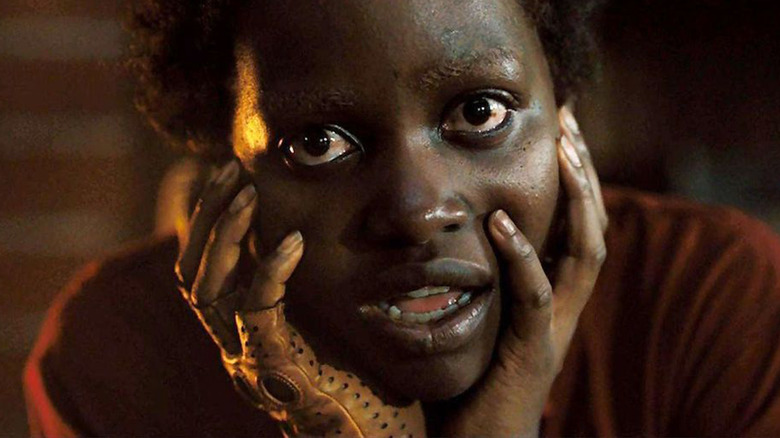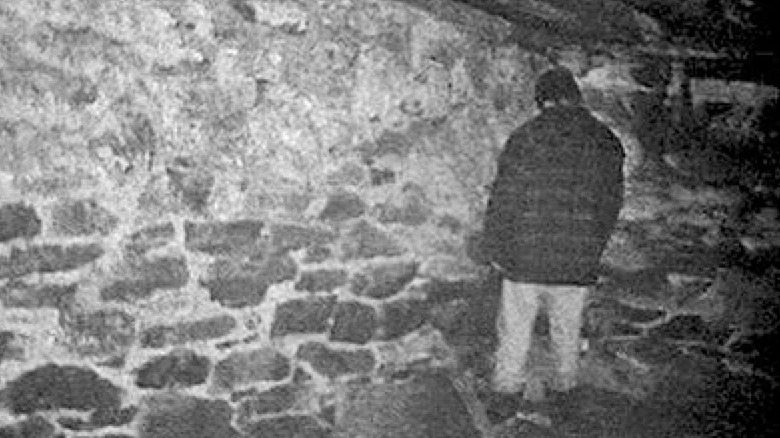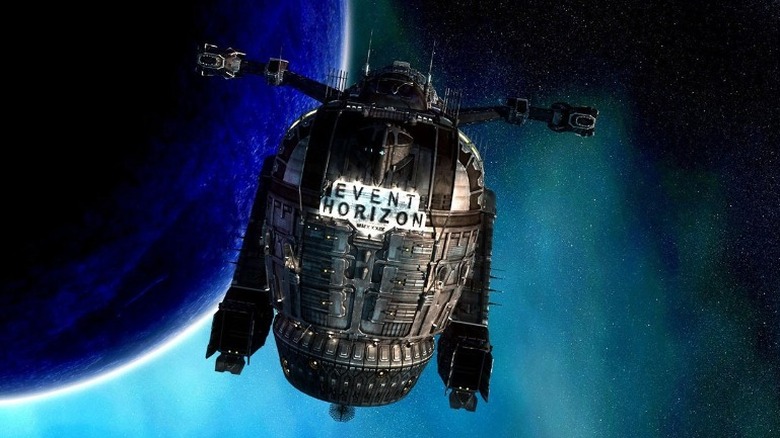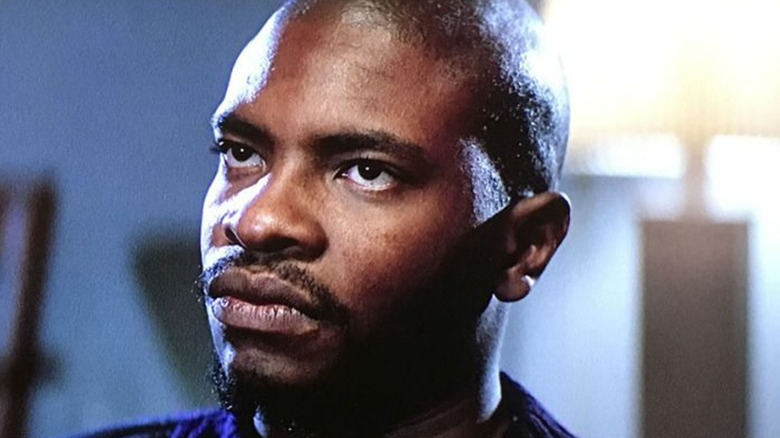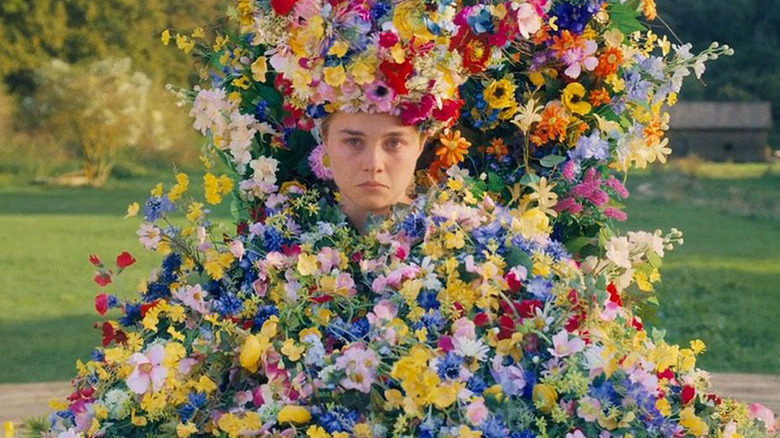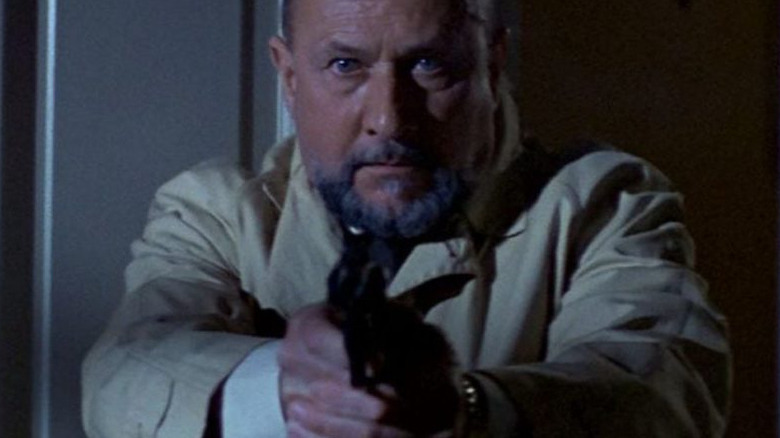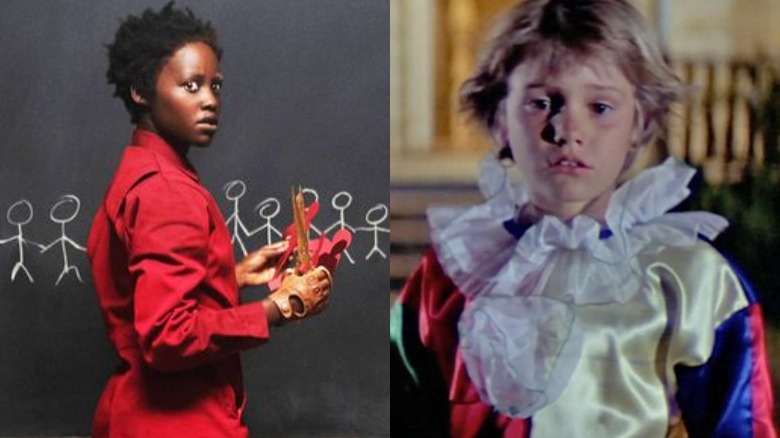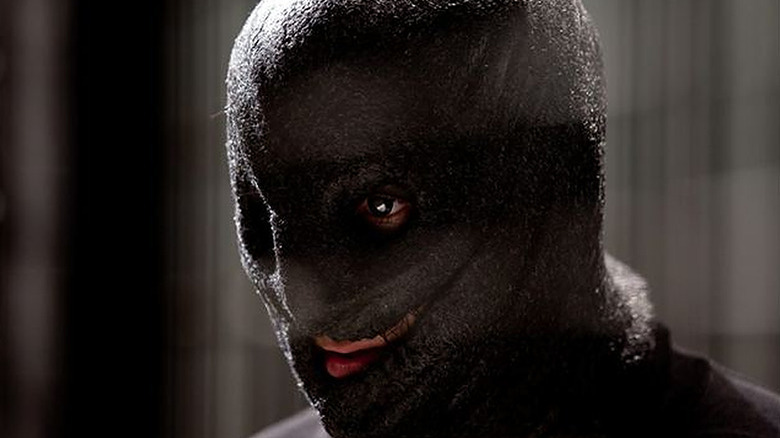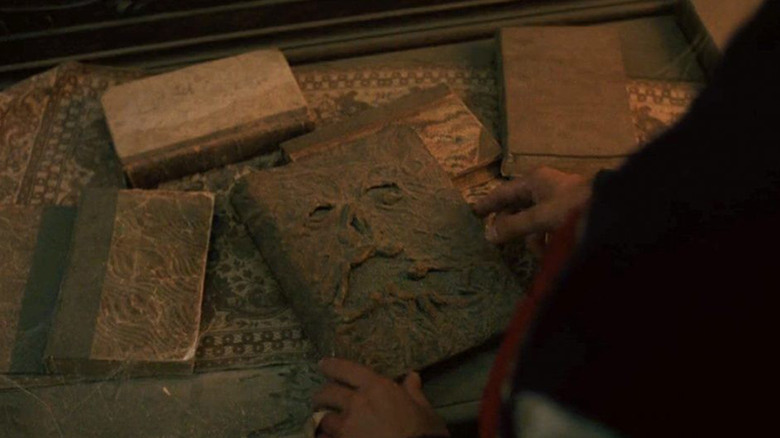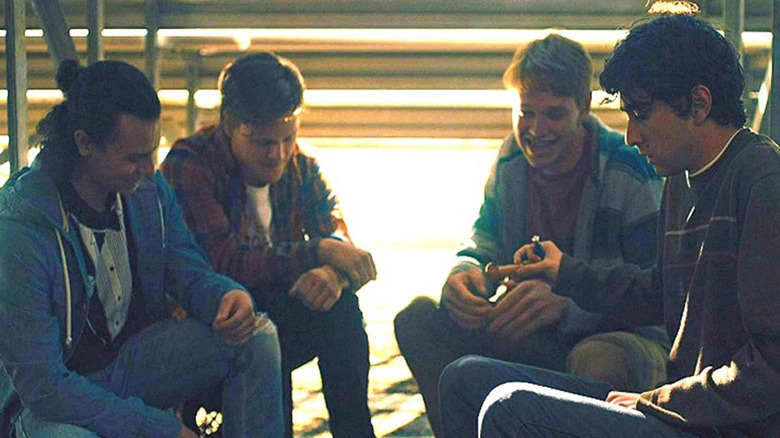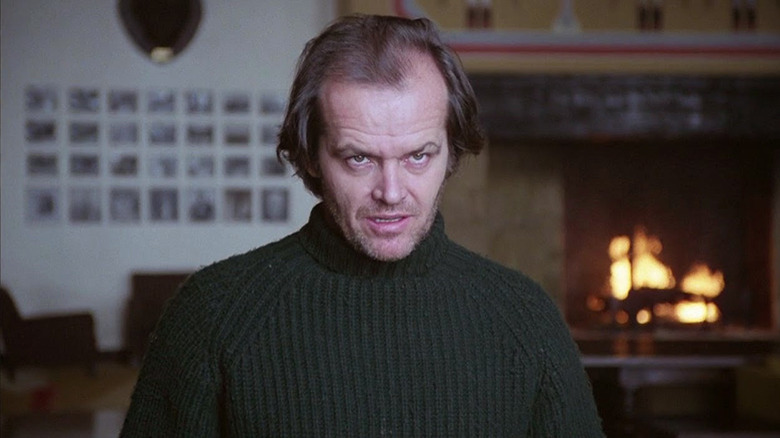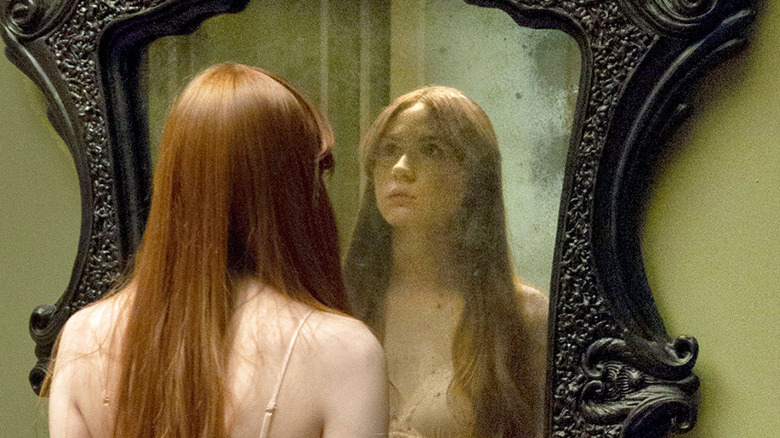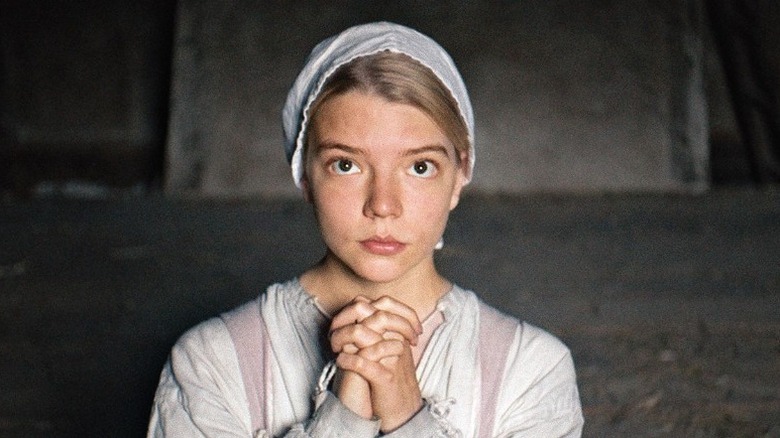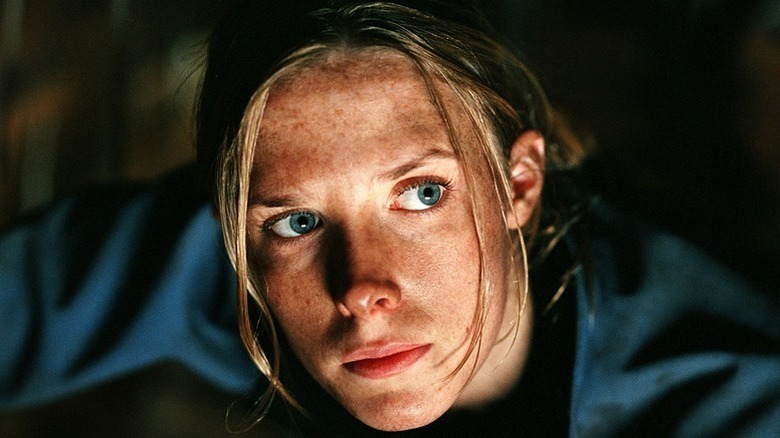Fan Theories That Make These Horror Movies Way Scarier
Like any genre, horror is populated with a wide variety of films from creators with radically different visions and styles. With that comes a tapestry of stories that have left themselves open to interpretation beyond what the creators might have intended, whether it be a hidden Easter egg, a vague piece of dialogue, or a deeper bit of lore that involves further investigation after the credits have rolled. From classics such as "Halloween," "The Thing," and "Hellraiser" to modern hits like "The Descent," "Hereditary," and "Us," the genre is rife with films that leave themselves open to countless theories and rampant speculation. It's impressive when a film can inspire conversations that last longer than their advertised runtime.
These are just a few choice theories that serve to not only fuel hours of compelling discussion, but make the films themselves even more terrifying. Be forewarned the following list contains spoilers for these movies and the frightening events within them, but if you don't feel like sleeping tonight, turn off the lights and dive into a horror theory rabbit hole.
The Blair Witch Project involves time travel
"The Blair Witch Project," concerning three college filmmakers who end up lost in the woods while hunting for titular Blair Witch, ends with the two remaining filmmakers entering a house in the woods. They are then taken out by some unseen figure. There are several theories about the identity of the killer, with one candidate being cameraman Josh — after succumbing to the witch's influence.
Of course, this theory only explains what happened to the humans — not their remains, their equipment, or how they got there in the first place. What most people miss is the very likely theory that the trio had been transported back in time upon entering the woods. The evidence for this is buried in the original website used to promote the film where it is noted:
October 16, 1995: Students from the University of Maryland's Anthropology Department discover a duffel bag containing film cans, DAT tapes, video-cassettes, a Hi-8 video camera, Heather's journal and a CP-16 film camera buried under the foundation of a 100 year-old cabin. When the evidence is examined, Burkittsville Sheriff Ronald Cravens announced that the 11 rolls of black and white film and 10 HI8 video tapes are indeed the property of Heather Donahue and her crew.
Now how exactly did the footage end up under a house that old when, in universe, they had only been missing for roughly a year? Time travel is often a lazy explanation for certain wonky elements in films, but here it is perfectly justifiable.
Event Horizon and Hellraiser take place in the same universe
Hell is where the heart is ... or rather where the pain is if these movies are to be believed. "Hellraiser", the film adaptation of Clive Barker's twisted masochistic fairytale "The Hellbound Heart," and "Event Horizon", Paul W.S. Anderson's 1995 cult classic cosmic horror film, seem to have very little in common aside from the surface level comparisons of their torture themed hellish visuals. But dig a little deeper and there might just be a bit more here to discuss.
First, both films share a common theme of pain meeting pleasure. This theme is cemented when the titular Event Horizon, a cosmic portal to hell, begins messing with the minds of the salvage crew's minds. Throughout "Event Horizon" we get to see the crew's worst nightmares amplified and thrown back in their faces. For example, Dr. Weir (Sam Neil), is treated to a haunting hallucination of his dead wife uttering the words "I have such wonderful things to show you" before re-taking her own life. This is very similar to Pinhead's (Doug Bradley) famous line "We have such sights to show you." Also, after Weir is fully corrupted by the power of the event horizon, his body is now adorned with and sickening markings comparable to those of the Cenobites from "Hellraiser".
Based on these visual and textual similarities, some theorize that perhaps the Lament Configuration from "Hellraiser" and the titular Event Horizon are related in some capacity.
Childs is the Thing
"The Thing" is another example of the genius of John Carpenter. It is story of men stationed at an research facility in the Antarctic, forced to contend with death and paranoia at the hands of a shapeshifting alien entity.
The film concludes with the alleged death of the creature. The two remaining survivors, MacReady and Childs, sit at the now burned out research facility. Despite their rampant distrust of each other, they pour out some scotch and wait for an uncertain rescue. It's a somber but mildly humorous ending that never quite dispels the paranoia.
It's an ending made creepier by a new theory: Childs could be the remaining imposter created by the entity. Commonly circulated evidence behind this claim are Childs' ever changing clothes throughout the film and the possibility that the drink MacReady (Kurt Russell) had provided him potentially gasoline instead of water.
Whether or not this question was ever intended to be answered is unclear, but it's a testament of the film's lasting paranoia that fans have debated this decades after its release.
Dani was always chosen in Midsommar
Ari Aster's sophomore outing, "Midsommar" concerns Dani (Florence Pugh), a girl dealing with both the death of her entire family and her emotionally distant yet manipulative boyfriend Christian (Jack Reynor). She joins her boyfriend and his friends on a trip to Sweden for a festival which turns out to be a cult ritual.
The film ends with Dani not only joining the cult, but allowing her cheating boyfriend to be engulfed in flames as she smiles. From the haunting soundtrack to the downright psychotropic visuals, it's no surprise so many viewers were left horrified and enthralled by this colorful dose of madness. However, viewers might've been so mesmerized that they missed a few clues that show that Dani may have always been chosen to join this cult.
It is revealed that Christian's friend Pelle (Vilhelm Blomgren) was instructed to bring enough fodder for the cult's sacrificial purposes, so the cult would have had knowledge of her prior to her arrival. Additionally, if you look closely by the parents' bed in the opening sequence you can see a picture of Dani adorned with various flowers around them.
Whether or not this was the doing of Pelle or just a fun bit of visual foreshadowing by the director is up for debate, but it does provide basis for this very haunting theory for an already haunting film.
Dr. Samuel Loomis is in Psycho and Halloween
Alfred Hitchcock's "Psycho" and John Carpenter's "Halloween" shared some DNA, both figurative and literally. For example, Jamie Lee Curtis, who portrays Laurie Strode in "Halloween," is the real life daughter of Janet Leigh, who starred as Marion Crane in "Psycho." Additionally, Dr. Samuel Loomis, played by the legendary Donald Pleasance in "Halloween," shares the same name as John Gavin's character from "Psycho."
However fans have speculated that this goes beyond just a fun nod from John Carpenter, and could quite possibly serve as a piece of connective tissue between both movies. There is a theory that Sam Loomis, inspired by his dealings with Norman Bates, took on psychiatry. This would eventually lead him to Smith's Grove Sanitarium where'd he would become Michael Myers' doctor for the duration of his life.
This would explain Loomis' almost encyclopedic understanding of evil, and how unfazed he seems by most of Michael's actions.
Michael Myers is a Tethered
Believe it or not, there's a good amount of evidence that connects John Carpenter's "Halloween" to Jordan Peele's "Us."
There have been many explanations to justify Michael Myers and his almost shark-like killing efficiency, from the simple to the incredibly convoluted, but consider for a moment what we know about the Tethered. They are mute, freakishly strong, and — in some cases — extremely fast. Now what do we know about Michael? He is mute, freakishly strong, and extremely fast. Considering the events that set "Us" in motion, how big of a stretch is it that a young Michael Myers was replaced by his tethered counterpart — much like what happened with Adelaide and Red — and went on to murder his sister that faithful Halloween night?
Considering how much influence the original "Halloween" had on Peele as a creator, this might be more likely than we realize.
The Collector is a failed Jigsaw protégé
The 2009 horror release "The Collector" is a tightly directed and thoroughly suspenseful cat-and-mouse-style film. It focuses on a jewel thief breaking into a house, only to find out he wasn't the first one to break in that night. As such, he finds himself the crosshairs of a sinister black masked figure subjecting a wealthy family to his painful tools of the trade.
The Collector himself is a fascinating character, as we are never told anything major about his backstory until sequel film "The Collection." It's mentioned that his father was a licensed entomologist, which can explain his fixation with the collection of once living organisms. Even so, there's still questions about his remarkable ability to create elaborate death traps. Wait ... a shadowy figure using dilapidated buildings as stages for elaborate games of death? This sounds familiar — almost like Jigsaw from the "Saw" films.
Sounds like a stretch, but given how fast and loose the "Saw" films have played it with continuity as of late, it may not be impossible to think that Jigsaw could've had another failed assistant much like Amanda and Hoffman. The film, when it was originally titled "The Midnight Man", was originally conceived as a "Saw" prequel film so this theory has some solid backing.
The Necronomicon is responsible for Friday the 13th and the Evil Dead
It's scary enough when a theory can affect your understanding of one horror series, let alone two at the same time.
The Necronomicon is most synonymous with the "Evil Dead" series, in which the chainsaw and boomstick wielding Ash Williams (Bruce Campbell) contends with the evil flesh bound tome and the Deadites it summons. However it seems the Book of the Dead is a popular library rental. Not only is it responsible for the adventures of Ash, but might just be partially responsible for the creation of Camp Crystal Lake's #1 Slasher: Jason Voorhees.
During a scene in "Jason Goes to Hell: The Final Friday," there is a moment where the Necronomicon is visible in the Voorhees home. This has so many implications, including a possible explanation on how the Jason keeps coming back from the dead, but it is interesting to see how both the Deadites and one of cinema's favorite slashers quite possibly share the same origins. Backing up this theory more is "Jason Goes To Hell" director Adam Curtis, who claimed to Horror Geek Life that he and "Evil Dead" creator Sam Raimi came up with the idea of the Necronomicon reviving Jason.
The Cult Members are everywhere in Hereditary
Ari Aster exploded onto the horror cinema scene with his hit film "Hereditary," a major critical hit concerning a family dealing with loss, grief, and the demons of their past coming back to haunt them. The film is still one of the most unrelenting, visceral, and shocking horror films to be given a mainstream theatrical release in sometime, and helped to establish Aster as one of the horror genre's defining creatives in the current age.
Characters from earlier in the film, such as those at the grandmother's funeral, come back later — fully revealed as members of the cult she was part of before her death. The film ends with the family all dead via the interference of the sinister satanic cult. Their deity, Paimon, found a new vessel in the body of the family's son Peter (Alex Wolff) — who is crowned "king" as he stands in front of an audience of his followers and his dead family members.
It's worth noting Peter makes his way to the ceremony one of the cult members bowing to him has a very similar hairstyle to one of Peter's friends, presented earlier in the film smoking with him under the bleachers. This has led to a theory that said friend was at the ceremony. Additionally, Joan (Ann Dowd), a friend of the mother Annie (Toni Collette), had slipped Annie some form of herb in her tea — likely to prepare for the ceremony seen in the climax. It could be possible that Peter's friend, via the "herbs" they were smoking, had done the same thing to Peter.
Jack Torrance is a test subject of MKUltra
"The Shining" is one of cinema's most analyzed films. Every critic, blogger, and fan has a theory or two about Stanley Kubrick's adaptation of one of Stephen King's most beloved works.
However one of the most compelling and disturbing theories might have a basis in true life events. Allow us to crack open the history book for a moment and summate the infamous MKUltra program. It was an illegal government program in which the CIA experimented on human test subjects, dosing them with drugs in an attempt to combat mind control. Truth is most definitely stranger than fiction — and possibly relevant to Jack Torrence (Jack Nicholson), the main character of "The Shining."
It's occasionally theorized that the caretaker position that Jack takes is a cover for the government to test drugs on the Torrances – and that Bill Watson, the person who gets the gig for Jack, is the mastermind behind this whole operation. That latter point made even more possible in the alternate ending of the film, which shows Watson may have been more aware of the Overlook's secrets than he let on.
The mirror from Oculus came from Hill House
Mike Flannigan is one of the leading minds in modern horror. Many know him specifically for the Netflix hit "The Haunting of Hill House", but his more hardcore fans will known him for his earlier hit "Oculus" starring "Doctor Who" alumni Karen Gillan. The film concerns two siblings reuniting to deal with a supernatural mind altering mirror, one that caused the death of their parents and messed with their brother until he ended up in mental hospital. The film addresses the history of the mirror and the various families it has destroyed over dozens of years.
This is important to note because, as pointed out by one eagle eyed fan on Reddit, featured in the background of "The Haunting of Hill House" is the very same mirror! Now this could be nothing more than an easter egg from Flannigan, just a fun way to include a prop from his previous work. However, considering the events of the show and how the inciting incident occurred in 1992, well before the events of "Oculus", it isn't an immense stretch to consider that the mirror could have originated at Hill House.
The Witch is in everyone's minds
Robert Eggers is another person leaving his unique stamp on modern horror. Both "The Witch" and "The Lighthouse" are already regarded as high marks in the genre. Both his films leave themselves very open to interpretation, and neither ever truly confirm if their events are the result of the characters' mental states or legitimate supernatural trickery.
Case in point, the events of "The Witch" could easily be chalked up to the meddling of 18th century witchcraft. It could also be attributed to, of all things, tainted crops. It is mentioned that the family's crops have developed an ominous black mold, which could very likely be a real life fungus known as ergot – something that causes legitimate LSD-like hallucinations.
These leaves two options for how anyone could see a talking black goat: witchcraft or hallucinogens. Which one was it here? You make the call, dear reader!
Sarah is the true killer in The Descent
"The Descent" is one of modern horror's more conflicting titles. Some regard it as an underrated modern masterpiece, while others see it as a confusing mess — but regardless of your thoughts on it, there is no denying it has a truly fascinating theory attached to it.
The plot concerns Sarah, a woman dealing with the loss of her husband and daughter, and her group of friends. They all head to Appalachian Mountains in North Carolina for some spelunking. While on their excursion, they are seemingly attacked by a swarm of beings known as crawlers. This leads to several tragic incidents, deaths, and heartbreaking revelations — including Sarah realizing that her late husband engaged in an affair with her friend Juno before his untimely death.
This is worth nothing because, due to Sarah's haggard mental state throughout the film, it is quite possible that there are no crawlers and Sarah is the one killing her friends. This is substantiated by one of the characters mentioning the "dehydration, disorientation, claustrophobia, panic attacks, paranoia, hallucinations, visual and aural deterioration..." that come with spelunking. It's also worth mentioning how easily Sarah is able to kill throughout the movie, once as a mercy and the other as an act of vengeance against Juno, who herself accidentally killed one of Sarah's other friends.
"The Descent" is a film with an already confusing narrative, so this theory definitely has enough grounds for discussion.
